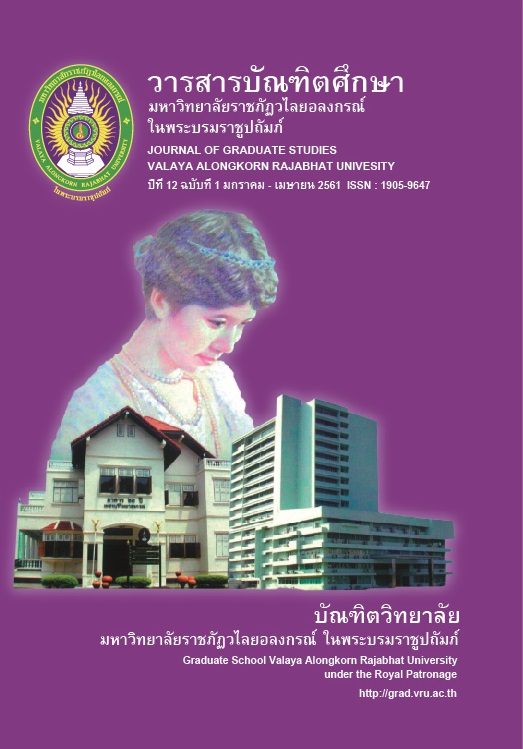การศึกษาภูมิหลังของนายกรัฐมนตรีทหารที่ส่งผลต่อรูปแบบการสื่อสารทางการเมือง
Main Article Content
Abstract
บทความวิจัยนี้มีจุดมุ่งหมายเพื่อศึกษาประวัติภูมิหลังของนายกรัฐมนตรีทหารที่ส่งผลต่อรูปแบบการสื่อสารทางการเมือง ด้วยระเบียบวิธีวิจัยเชิงคุณภาพ เก็บรวบรวมข้อมูลด้วยวิธีวิจัยเอกสารของภาครัฐและทางวิชาการร่วมกับการสัมภาษณ์เชิงลึกจากผู้เชี่ยวชาญทางด้านรัฐศาสตร์และสื่อสารการเมือง ผลการศึกษาภูมิหลังของผู้นำทั้ง 5 คน พบว่า จอมพลถนอม กิตติขจร จอมพลสฤษดิ์ ธนะรัชต์ และพล.อ.ชวลิต ยงใจยุทธ เติบโตจากครอบครัวชนชั้นสูง ส่วน พล.อ.เปรม ติณสูลานนท์ และพล.อ.ประยุทธ์ จันทร์โอชา เติบโตจากครอบครัวชนชั้นกลาง ซึ่งผู้นำทั้ง 5 คนมาจากครอบครัวข้าราชการพลเรือนและทหาร และผ่านการศึกษาจากโรงเรียนนายร้อยพระจุลจอมเกล้าทั้งหมด ซึ่งปัจจัยที่ส่งผลต่อบุคลิกลักษณะและการแสดงออกทางการสื่อสารมาจากเงื่อนไขด้านภูมิหลังเป็นสำคัญ รูปแบบการสื่อสารของผู้นำทั้งหมดสามารถแบ่งได้ 2 ลักษณะ คือ จอมพลถนอม กิตติขจร พล.อ.เปรม ติณสูลานนท์ และพล.อ.ชวลิต ยงใจยุทธ พูดจาสุภาพ เรียบร้อย ให้เกียรติผู้อื่น ระมัดระวังการพูดและหลีกเลี่ยงการสร้างศัตรู และรูปแบบการสื่อสารอีกลักษณะหนึ่ง คือ จอมพลสฤษดิ์ ธนะรัชต์ และพล.อ.ประยุทธ์ จันทร์โอชา มีเอกลักษณ์การสื่อสารที่คล้ายกันคือ พูดจาเสียงดังกังวาน ชัดเจนและดุ ส่วนกลยุทธ์เนื้อหาสารของผู้นำทั้ง 5 คนเลือกใช้กลยุทธ์สารแบบชัดเจน โดยจอมพลถนอม กิตติขจร จอมพลสฤษดิ์ ธนะรัชต์ และพล.อ.เปรม ติณสูลานนท์ เลือกการปราศรัยเป็นช่องทางหลักสำคัญในการสื่อสาร พล.อ.ประยุทธ์ จันทร์โอชา ใช้แถลงการณ์ในรูปแบบของคลิปวีดีโอเป็นช่องทางหลัก ส่วน พล.อ.ชวลิต ยงใจยุทธ ไม่ปรากฏความโดดเด่นในการใช้ช่องทางการสื่อสารสู่กลุ่มเป้าหมายทางการเมือง
This article arisen to study of the background of the military prime ministers by using qualitative research method. Data was collected from governmental and academic documents research together with in-depth interview from Political Science and Political Communication experts. The research revealed that the background of five leaders, Field Marshal Thanom Kittikachorn, Field Marshal Sarit Dhanarajata and General Chavalit Yongchaiyudh were born to the aristocratic families. While General Prem Tinsulanonda and General Prayut Chan-o-cha had grown from a middle class families. All 5 leaders were from civil servant and military families and graduated from Chulachomklao Royal Military Academy. Factors affecting the personality and communication were mainly from background. Communication forms of all leaders could be classified into two types; Field Marshal Thanom Kittikachorn, General Prem Tinsulanonda and General Chavalit Yongchaiyudh were soft-spoken, well-mannered, honored the others, spoke cautiously and avoid making enemies. While Field Marshal Sarit Dhanarajata and General Prayut Chan-o-cha had a similar unique communication forms that were speaking in a loud, clear voice and stern look. About the information content strategies, all 5 leaders chose an explicit content strategy; Field Marshal Thanom Kittikachorn, Field Marshal Sarit Dhanarajata and General Prem Tinsulanonda selected speech as a main channel of communication and General Prayut Chan-o-cha preferred official statement in a form of video clips. Whereas General Chavalit Yongchaiyudh had no remarkable communication channel usage to communicate with target political groups.
Article Details
บทความทุกเรื่องได้รับการตรวจความถูกต้องทางวิชาการโดยผู้ทรงคุณวุฒิ ทรรศนะและข้อคิดเห็นในบทความวารสารบัณฑิตศึกษา มหาวิทยาลัยราชภัฏวไลยอลงกรณ์ ในพระบรมราชูปถัมภ์ มิใช่เป็นทรรศนะและความคิดของผู้จัดทำจึงมิใช่ความรับผิดชอบของบัณฑิตวิทยาลัย มหาวิทยาลัยราชภัฏวไลยอลงกรณ์ ในพระบรมราชูปถัมภ์ กองบรรณาธิการไม่สงวนสิทธิ์การคัดลอก แต่ให้อ้างอิงแหล่งที่มา
References
คำแถลงนโยบายนายกรัฐมนตรี. (2558). คำแถลงนโยบายนายกรัฐมนตรี. ระบบออนไลน์: www. librarymb.parliament.go.th/library., 20 กุมภาพันธ์ 2558.
ทักษ์ เฉลิมเตียรณ. (2552). การเมืองระบบพ่อขุนอุปถัมภ์แบบเผด็จการ. พิมพ์ครั้งที่ 3. กรุงเทพฯ: ศูนย์หนังสือจุฬาลงกรณ์มหาวิทยาลัย.
โรงเรียนนายร้อยพระจุลจอมเกล้า (จปร.). (2559). ภารกิจและปรัชญา. ระบบออนไลน์: www.crma.ac.th., 9 มีนาคม 2559.
สมควร สาคร. (2554). บทบาททางการเมืองและกลยุทธ์การสื่อสารทางการเมืองของทหารในภาวะวิกฤตทางการเมืองไทย: กรณีศึกษาระหว่างวันที่ 19 กันยายน พ.ศ. 2549 ถึงวันที่ 13 เมษายน พ.ศ. 2552. ดุษฎีนิพนธ์, มหาวิทยาลัยเกริก, วิทยาลัยสื่อสารการเมือง.
Chaney, Lillian H., & Green, Catherine G. (2004). Difference in verbal and nonverbal communication styles of military and nonmilitary personnel: A comparison of two populations. Allied Academies International Conference, Retrieved
December 12, 2014, Retrieved from https://www.alliedacademies.org/public/proceedings/proceedings15/paoccc-9-2-maui04.pdf
Ferguson, S. D. (1999). Communication Planning. California: Thousand Oaks.
Janowitz, Morris. (1987). Military Institutions and Coercion in the Developing Nations. Chicago: University of Chicago Press.
McNair, Brain. (2011). An Introduction to Political Communication. 5th ed. New York: Routledge.
Nordinger, Eric A. (1977). Soldiers in Politics: Military Coups and Government. Englewood Cliffs, N.J.: Prentice Hall.


